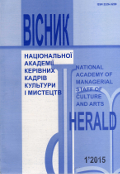STYLISTIC ASPECTS OF ADAPTATION THE NATIONAL TRADITION IN INSTRUMENTAL PIANO MUSIC OF CONTEMPORARY CHINESE COMPOSERS
DOI:
https://doi.org/10.32461/2226-3209.1.2015.138348Keywords:
Chinese folk, instrumental tradition, piano, voice, tone simulation, the sound imageAbstract
The article deals with the interaction of Chinese folk music with the practice of Chinese composers of the twentieth century. The issues of implementation of China's traditional musical culture in piano music. Identifies principles of adaptation isntrumental specifics of Chinese music to the expressive possibilities of the piano and performing. The purpose of the article – to identify specific guidelines adaptation of folk music of China in terms of piano expressiveness in the works of modern Chinese composers.
Universal technological and expressive possibilities of the piano became urgent for Chinese composers of thetwentieth century, who in their work relied on the traditions of their national musical culture. Musical tradition of China issignificantly different from the classical European. In their works, Chinese composers inherited tonal and rhythmicspecificity of Chinese folk music, the characteristical sound of the voices of Chinese folk instruments and playingtechniques to them. In their piano works, they were on the way to adapt "native" musical material to the expressivepossibilities of a "foreign" tool. This synthesis is largely determined the national character and style specifics of Chinesepiano music.
The consequence of this composer's method was to the fore such forms of piano music as arrangement andtranscription of songs and instrumental samples of Chinese folk music.Chinese composers of the twentieth century in their piano works based on folk traditions of their musical culture,and this is reflected in the melodic, harmonic, intonation, rhytmical and sonoric level of their works.An example of the refractive index of the creative adaptation of national folklore and expressive potential of thepiano to the specific timbre of Chinese folk instruments is to play Lee Inhaj "Chinese flute and the drum at dusk." Thiswork is a vivid imprint in a piano sound dialogue between the two instruments – the Chinese flute and drum. Soundimage of colorful instrumental timbres embodied in the specific decision textured, dynamic, rhytmic and articulation pianoexpressiveness.
Among the stylistic features of the works of Lee Inhaj note the following: a thematic link with the national culture; reliance on Chinese folk songs as tonal and thematic basis of a musical work; adaptation to the piano texture and tonalvariety of performance techniques of Chinese instrumental tradition; leading role in the principle of individual creativebreaking of national musical traditions.
Downloads
Published
Issue
Section
License
Authors who publish with this journal agree to the following terms:
1. Authors retain copyright and grant the journal right of first publication with the work simultaneously licensed under a Creative Commons Attribution License International CC-BY that allows others to share the work with an acknowledgement of the work's authorship and initial publication in this journal.
2. Authors are able to enter into separate, additional contractual arrangements for the non-exclusive distribution of the journal's published version of the work (e.g., post it to an institutional repository or publish it in a book), with an acknowledgement of its initial publication in this journal.
3. Authors are permitted and encouraged to post their work online (e.g., in institutional repositories or on their website) prior to and during the submission process, as it can lead to productive exchanges, as well as earlier and greater citation of published work (See The Effect of Open Access).


